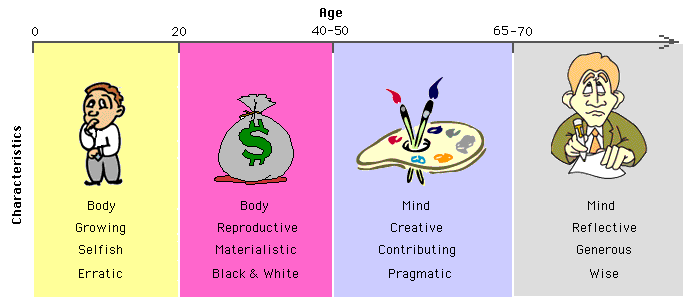15. Genes, memes and the four Phases of LIfe
------------------------------
Previous - Next - Contents
 Before I go on first another metaphor for the nature of genes.
Before I go on first another metaphor for the nature of genes.
Think about the development of the car, from the early Vintage models to
the present day high tech computerised models. Development has been gradual and
progressive over the past, what ? 100 years or so. But not every new model was
a total make over, far from it.
Perhaps one year a new ignition system was
developed, the next model the braking system was improved. After that perhaps a
new type of carburetor was invented and installed. In other words the evolution
of the car took place by means of numerous small steps through the improvements
and inventions of the various individual components. In hind sight you might say
: "Geeh, that particular carburetor was a successful one. It was used for over
40 years without a single modification."
This is exactly how the evolution of DNA takes place. Individual genes (small
DNA segments) may last over numerous generations provided they continue to be
useful and as long as there is no better alternative gene to replace it. Note
that in above metaphor a gene is comparable with the design of say a
carburetor, it is not the actual carburetor itself. Also a gene
(like a carburetor design) has no foresight. Only in retrospect after
numerous generations can we say : "That gene has been very persistent and
useful".
However it helps to think as if genes do have
foresight, as this makes it easier to understand their evolutionary
development trends. Dawkins uses this approach throughout his book ("The Selfish
Gene"), including its very title. A gene is not selfish, only when seen in
hindsight its effect makes it seem to be so. So I will do the same here.
Now on with the real issue I want to discuss today.
Up until about 500 years ago (or perhaps until even more recent than that) the
life expectancy of a human being was around 40 years. Now look at
my Diagram of the four Phases of Life I presented the other day.
Isn't that
interesting !! The 40 year life span covers exactly the first two Phases
of Life, the Growth Phase and the Reproductive Phase.
This is
of course exactly where the " self interest" of genes lies. It is
important for them that a human body growth to its full physical maturity, so
that it then can reproduce and by doing so ensures the continued
propagation of the genes.

What happens after that is of little interest to the gene pool and the
human body sure feels the effect of that. Its strength starts to decline,
female fertility soon stops altogether. The man cans still do his bit, be it at
a somewhat more modest pace, for who knows he may mate up with a younger female
again. But further down the track it is (at least physically) all down
hill in every way.
Over the past few hundred years however things have changed dramatically. As a
result of much improved lifestyles for every body, plus better nutrition,
effective countermeasures against various plagues and illnesses and an overall
improved health system, the human life expectancy has steadily
increased, and has now for developed countries reached into the
80s, about double the length of what it was originally.
This has opened
up a incredible window of opportunity for further human development. This
time this development is not focused on the body, but instead on the
mind, allowing us to live through two additional Life Phases, the
Creative Phase and the Reflective Phase.
Genes appear to "have no quarrel with that". In
fact to the contrary, they seem to actively support this long life development,
as the present evolution process of the human species is highly focused on
further development of the brain, which (according to modern biologists)
is proceeding at well above average evolution pace !
This leads me to the following conclusion, as illustrated by the Diagram
below.
For the first two phases of our life we largely follow the "selfish"
instructions of our genes (the initial replicator). We grow up, we marry
and we raise children. The genes are happy and we are now allowed to do "our own
thing" during the next two phases of our life.

The time has therefore arrived to focus on the effect of the second
replicator, the memes. We absorb and perhaps extend or modify
existing memes (ideas, thoughts, art works, etc.) and we produce new ones.
We discover who we are, express ourselves in creative ways and reflect on the
world and Universe around us and how we fit in.
I sense in the writing of some authors an "us and them" attitude. "They" are the
"replicators with all the control", "we" are the obedient survival vehicles
(Dawkins' "survival machines"). This was perhaps initially very true indeed.
But the whole direction of evolution, especially of the human species, is
moving into the direction of a fully co-operative approach between genes, memes
and us their carriers and nurturing hosts. After all, why this strong trend
towards better brains ? Surely it is aiming to allow us more control over the
direction of modern evolution trends into the future.
Finally, how do I, as a professed atheist see my role in this scenario ?
I, like you, and like everybody else, am the effect of a unique genes
combination. I am like a one only hand made unique piece of art, never to
be repeated or copied again. But each successive generation my genes
contribution will half. So after just a few generations there will be little of
it left.
The memes I create on the other hand have the potential to
live on for a long time. Especially with the modern technology, like Internet,
CDs etc., much of what I try to contribute to the world has the possibility to
last. If it proves to be good enough, and I am quite confident it is, it may
survive for quite a long time. That is more than enough for me to live and to
hope for.
Next Page -
Top of Page
Copyright © 2010 Michael Furstner
|


